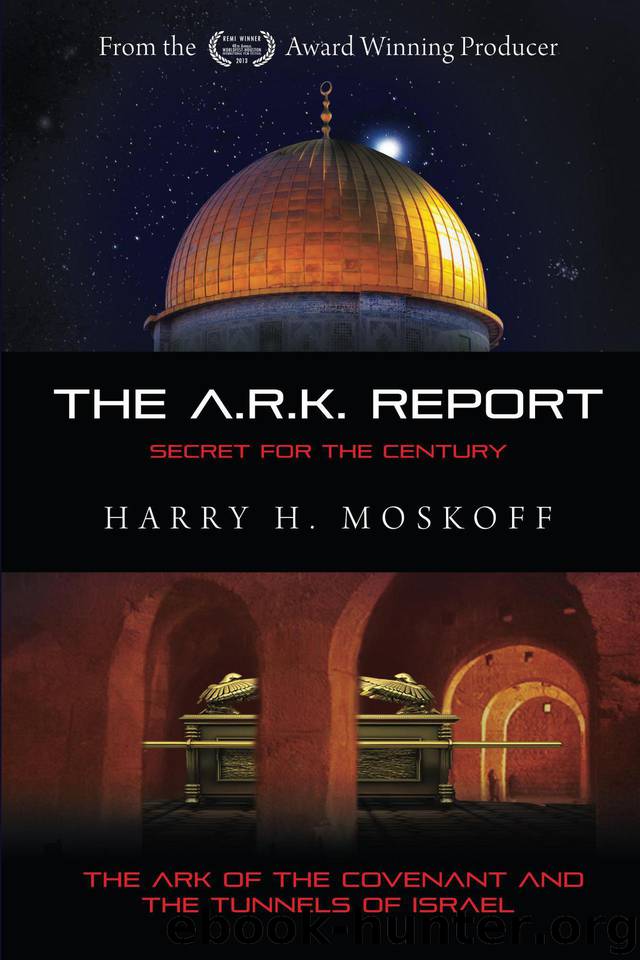The ARK Report: The Ark of the Covenant and the Tunnels of Israel (The A.R.K. Report Book 1) by Moskoff Harry H

Author:Moskoff, Harry H. [Moskoff, Harry H.]
Language: eng
Format: epub
Publisher: Unknown
Published: 2014-08-31T16:00:00+00:00
AUTHOR’S NOTE: I am in agreement with both the above account by Wilson, and Deen Ritmeyer’s opinion that this cistern is a reservoir that was quarried out under the Mount, possibly identifying it also with the “Bor HaGola”. 89 This large cistern would have been situated next to the Water Gate. A wheel was set over it to draw water. 90
Other theories of where the temples were located do not necessarily map out because they necessitate that the Eastern and Western walls were never in perfect parallel alignment during the First Temple period. This would go against what it says in the Mishnah regarding the specifications of Har Habayit, the Temple Mount. It also means that King Joshafat91 would have purposely designed the platform to be extended in this type of quadrangular shape, which is in contrast to the Tabernacle Courtyard, where all the basic Temple structural plans are essentially based, and its divine commandment to be built strictly symmetrical.
Thus, the current southern wall was in fact not built on top of the original, and is the Herodian extension. This extension was the platform for the Royal Stoa/Portico, which had become part and parcel of the Hasmonean Temple Mount itself (which had previously dated back to its recapture around 165 B.C.E.). Sometime during the construction of the extension, Herod dismantled the original portico and moved/rebuilt it majestically to sit at the new southern end.
89 Eruvin 10:14
90 As mentioned in Middot 5:3.4
91 See Mesechet Yavomot 7 b
Note that according to the Rambam the whole platform in general had been already sanctified, along with the new boundaries of Jerusalem, centuries before by Ezra HaSofer and Nechemiah.
There are many strictly archaeological discoveries that also defend the Moskoff Theory. One of the primary ones can be found in a book by Meir Ben-Dov (1982): In the Shadow of the Temple: The Discovery of Ancient Jerusalem. There he tells of his discovering the mesibot, the special tunnels that were carved out of the rock underneath the Temple Mount’s (Triple) gates to enable ritually impure priests to leave the consecrated Temple compound, descending into a small cistern or ritual bath: a mikveh .92
It is interesting to note that the other end of this tunnel would thus have to lead to the large chamber called the Lishkat Bet HaMoked, or Chamber of the Fire, where all the priests slept and kept warm when not serving. Unfortunately, the tunnel was deliberately blocked, and therefore cannot be followed to the other end where, according to all opinions, the exact location of this particular room and subsequently the rest of the Temple complex, would be found—including the exact position of the sacrificial altar, and the Holy of Holies itself!
That would certainly be the ‘easy’ way to confirm this theory and to ascertain the location of the whole Temple complex. But in the meantime, what we can take away from this discovery is that it makes sense to place the Temples more towards the southern slope of the mountain where the underground tunnels would be a shorter distance to this ritual bath.
Download
This site does not store any files on its server. We only index and link to content provided by other sites. Please contact the content providers to delete copyright contents if any and email us, we'll remove relevant links or contents immediately.
| Africa | Americas |
| Arctic & Antarctica | Asia |
| Australia & Oceania | Europe |
| Middle East | Russia |
| United States | World |
| Ancient Civilizations | Military |
| Historical Study & Educational Resources |
German, Jew, Muslim, Gay by Marc David Baer(953)
Letters to a Young Contrarian by Christopher Hitchens(914)
American Prophets by Jack Jenkins(821)
Unholy by Sarah Posner(686)
Shapiro, Ben - The Right Side of History by Shapiro Ben(645)
The End of Empathy by John W. Compton(616)
M31 by Stephen Wright(612)
Sacred Causes by Michael Burleigh(588)
Jihad & Co. - Black Markets and Islamist Power by Aisha Ahmad(565)
ERADICATE - Blotting Out God in America by Fiorazo David(535)
Atheist Universe by David Mills(524)
The Theft of America's Soul by Phil Robertson(507)
Sacred Liberty by Steven Waldman(499)
The Family by Sharlet Jeff(485)
C Street by Jeff Sharlet(467)
The Jefferson Bible - Life And Morals Of Jesus Of Nazareth by Thomas Jefferson(462)
Beyond Terror: Islam's Slow Erosion of Western Democracy by Anne Marie Waters(455)
Doing Theology in the Age of Trump: A Critical Report on Christian Nationalism (Westar Seminar on God and the Human Future Book 0) by Robbins Jeffrey W(454)
C Street: The Fundamentalist Threat to American Democracy by Jeff Sharlet(453)
